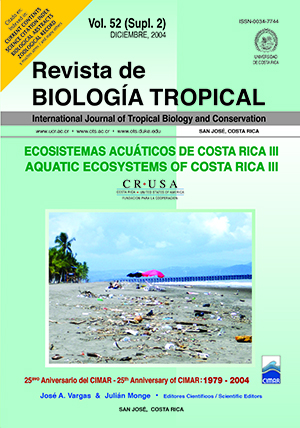Abstract
Sharks are highly vulnerable to intense and prolonged fishery extraction. This article analyzes the data on shark landings from the artisan fishing fleet on Costa Rica’s Pacific coast between 1988 and 1997. The data come from an invoicing system administered by the Costa Rican Fisheries Institute (Instituto Costarricense de la Pesca y Acuacultura, INCOPESCA). Pacific coast shark fishing during the period under study represented approximately 20% of the total national fisheries volume. According to data from the invoicing system, the Northern Pacific region was the most productive, reporting 58% of the shark catch nationwide. Within this region, shark fishing in Papagayo Gulf represented 91% and 53% of the landings by fishery region and nationwide, respectively. The mid-sized and advanced (length of boat > 10 meters) artisan fishing fleets reported 96% of the shark catches in the zone. The study of shark fisheries in the Papagayo Gulf zone is crucial for an understanding of fishery dynamics for this resource at the national level. A monthly chronological series was constructed with the landings in the Papagayo Gulf zone, and a Univariate Box-Jenkins (UBJ) Model was estimated for first-order moving averages MA(1) with a seasonal component of the Yt = λat −1 + γS12 + at type.References
Anderson, O.D. 1976. Time Series Analysis and Forecasting; The Box-Jenkins Approach. Butterworth and Co. London. 182 p.
Box, G. E. P& G. M. Jenkins. 1976. Time Series Analysis: Forecasting and Control. Holden-Day Press. San Francisco. 130 p.
Bonfil, R. 1994. Overview of World Elasmobranch Fisheries. FAO Fish. Tech. Paper 341. Rome. 77 p.
Box, G. E. P. & D. A. Pierce. 1970. Distribution of residual correlations in autoregressive-integrated moving average time series models. J of the Amer. Stat. Assoc. 65, 1509-1526.
Castillo, J.L., J. Márquez, A. Cid del Prado, S. Soriano & S. Ramírez. 1997. Descripción, evaluación y manejo de la pesquería artesanal de tiburón de Puerto Madero, Chiapas, México. Instituto Nacional de la Pesca. México. 13 p.
Castro, J. I., C. M. Woodley & R. Brudek. 1999. A Preliminary Evaluation of the Status of Shark Species. FAO Fish. Tech. Paper 380. Rome. 150 p.
Hoening, J. & Gruber, S. 1990. Life-history pattern in the elasmobranch: Implication for Fisheries Management. US Dept. of Commerce, NOAA Tech. Rep. 90: 1-16 p.
Nelson, J. 1994. Fishes of the World. Wiley & Sons. New York. 600 p.
Pankratz, A. 1983. Forecasting with Univariate Box-Jenkins Models. Wiley & Sons. New York. 562 p.
Rojas, R., J. Campos, M. Mug & A. Segura. 1999. Diagnóstico de la Pesca de Tiburón en Centroam érica, p. 50-53. In CIMAR (eds.). Memorias XX Años de Investigación: Centro de Investigación en Ciencias del Mar y Limnología CIMAR 1979-1999. Universidad de Costa Rica. San José.
Vannuccini, S. 1999. Shark Utilization, Marketing and Trade. FAO Fish. Tech. Paper 389. Rome. 130 p.
##plugins.facebook.comentarios##

This work is licensed under a Creative Commons Attribution 4.0 International License.
Copyright (c) 2004 Revista de Biología Tropical


